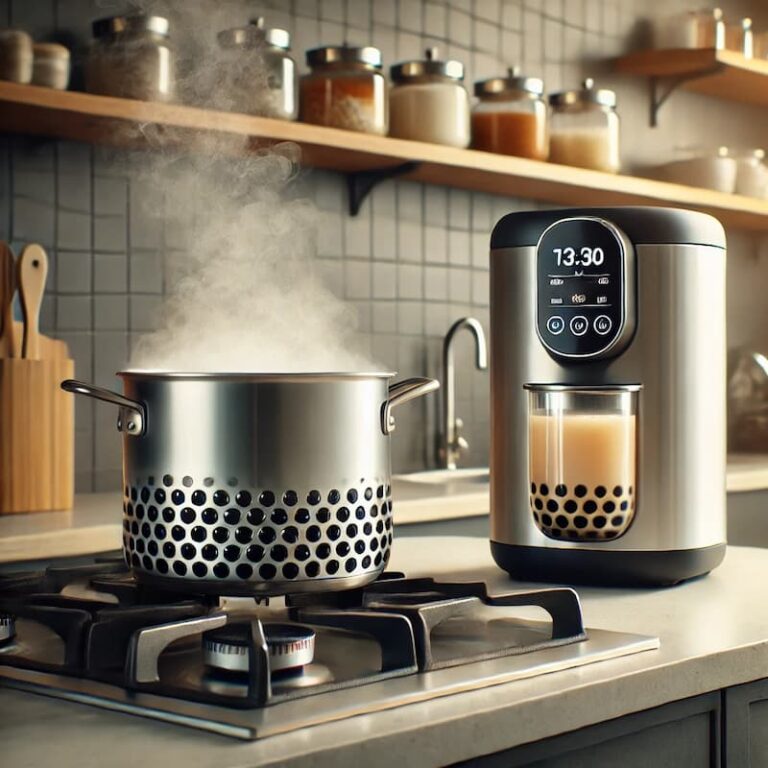

Can you cook tapioca pearls without a cooker? Yes! Explore creative methods and why a cooker delivers better consistency and ease.
For many, cooking tapioca pearls without a cooker is about accessibility. Whether they’re on a tight budget, experimenting in the kitchen, or working with limited space, people often look for alternative ways to prepare their favorite bubble tea ingredient.
Many home cooks may not have access to specialized equipment, making stovetop or microwave methods their go-to solutions. Cooking tapioca pearls without a cooker eliminates the need for extra purchases and simplifies the process, making it more accessible for beginners. However, these methods require more attention to detail and manual adjustments to get the desired texture. Home cooks must constantly monitor boiling water, adjust the heat, and stir frequently to prevent clumping—a hands-on approach that can still produce satisfying results.
For those just starting their bubble tea journey, investing in a dedicated cooker might feel like an unnecessary expense. They often rely on existing kitchen tools, like pots and microwaves, to save money. This approach works well for small batches but can be inefficient for larger quantities. Additionally, the lack of automation means the process can be prone to errors, leading to inconsistencies in texture or flavor. Despite these challenges, the cost savings can make this a worthwhile option for beginners testing the waters of tapioca pearl cooking.
Some people love the challenge of cooking with limited resources. It’s a fun way to experiment and develop new techniques while mastering the art of cooking tapioca pearls. Whether steaming pearls over boiling water or using unconventional methods like slow cookers or sous vide machines, these inventive cooks often push boundaries. However, they must also adapt recipes and timings to suit their chosen method, which can lead to mixed results but offers an opportunity for creative learning.
Tapioca pearls are the star ingredient of bubble tea, known for their chewy texture and delightful bite. To achieve the perfect consistency, it’s crucial to understand their composition, types, and cooking needs.
Tapioca pearls are made from tapioca starch, derived from the cassava root, and are naturally gluten-free. Their signature chewiness is a result of their high starch content, which requires proper hydration and cooking to achieve the desired texture. Tapioca pearls come in a variety of sizes and colors, with black pearls being the most popular for bubble tea. Understanding the type you’re working with is essential, as smaller pearls cook faster while larger pearls demand more precision and time.
The market offers a wide range of tapioca pearls, from quick-cooking varieties to traditional pearls that take upwards of an hour to prepare. Instant pearls are pre-treated for convenience, while classic pearls require soaking and extended cooking times. The type of pearl you choose impacts the cooking method; for example, microwave methods work better for instant pearls but are less effective for traditional ones. Familiarity with your specific type of pearl ensures you adjust cooking times and techniques appropriately for the best results.
One of the key challenges of cooking tapioca pearls is achieving uniform texture throughout. Overcooking can turn pearls mushy, while undercooking leaves them chalky and hard at the center. This balance is critical, as it determines the pearls’ ability to complement the drink they’re served in. Consistent cooking ensures a chewy, satisfying bite and enhances the overall bubble tea experience. For this reason, many prefer automated cookers for their ability to control variables like temperature and timing.
Cooking tapioca pearls without a cooker requires creativity and adaptability. While it’s not as automated or consistent as using a dedicated cooker, several methods can yield satisfying results with some patience and attention.
The stovetop method is the most common alternative to a cooker. Start by bringing a pot of water to a boil—use a ratio of at least 6 cups of water per cup of tapioca pearls to prevent sticking. Once the water is boiling, add the pearls and stir them frequently for the first 5-10 minutes to ensure they don’t clump together. Reduce the heat to medium and let the pearls simmer, covered, for 20-30 minutes, stirring occasionally. Afterward, turn off the heat and let the pearls sit in the hot water for an additional 10-15 minutes to ensure they’re fully cooked. Drain and rinse the pearls with cold water to stop the cooking process and achieve their signature chewy texture.
This method is versatile but requires close monitoring to avoid overcooking or uneven results. Additionally, achieving the perfect chewiness can take some trial and error.
Microwaving tapioca pearls is a faster but less precise method. Start by adding the pearls to a microwave-safe bowl with enough water to cover them completely, plus an extra inch. Microwave on high for 2-3 minutes, stir, and then microwave for another 2-3 minutes. Check the texture after each interval and continue microwaving in 1-minute increments until the pearls reach the desired consistency.
While convenient, this method works best with instant or small-sized pearls. Larger pearls may cook unevenly due to the limitations of microwave heating. Additionally, frequent stirring and observation are necessary to prevent the pearls from drying out or becoming unevenly cooked.
Innovative cooks have experimented with other ways to cook tapioca pearls without a traditional cooker. For example:
Each of these methods requires adjustments to time and temperature, and results may vary. They are ideal for those who enjoy experimenting and don’t mind taking the time to fine-tune their techniques.
While cooking tapioca pearls without a cooker is feasible, using a dedicated cooker provides unmatched consistency, convenience, and efficiency. A cooker eliminates much of the guesswork and effort, especially when preparing pearls regularly or in large batches.
A cooker is designed to control temperature and timing with precision, ensuring uniform texture across all pearls. This is particularly beneficial for larger pearls that require even cooking throughout. With manual methods, it’s easy to undercook the center while overcooking the outer layer. Cookers avoid this issue by maintaining consistent heat distribution, resulting in perfectly chewy pearls every time. This consistency is crucial for businesses where customer satisfaction depends on reliable quality.
Manual methods demand constant attention—stirring, adjusting heat, and monitoring water levels. A cooker streamlines this process with pre-set programs or timers, allowing you to focus on other tasks while the pearls cook. Many cookers can handle multiple batches consecutively with minimal input, making them an excellent time-saving solution for busy kitchens. The efficiency of a cooker ensures you can prepare pearls quickly and effortlessly, even during peak hours.
For commercial operations or large gatherings, a cooker shines in its ability to handle multiple batches efficiently. Manually cooking large quantities of tapioca pearls can be tedious, requiring frequent water changes and constant supervision. Cookers, on the other hand, are built to handle high volumes with consistent results, making them ideal for bubble tea shops or events where demand is high. They also reduce the margin for error, ensuring each batch meets the same high standard.
When it comes to cooking tapioca pearls, the results from manual methods and a dedicated cooker can vary significantly. While both approaches can yield edible pearls, the differences in consistency, convenience, and overall quality are often stark.
Manual methods often struggle with achieving uniform texture. On a stovetop, pearls can overcook on the outside while remaining undercooked in the center, especially if not stirred frequently. Microwaving or other unconventional techniques may result in uneven cooking, with some pearls turning mushy while others stay hard. In contrast, cookers provide consistent heating and timing, ensuring that every pearl is evenly cooked and chewy. For those who value the signature “bounce” in their tapioca pearls, a cooker delivers superior results.
Cooking tapioca pearls without a cooker requires constant attention, from boiling water to stirring regularly and checking doneness. It’s a labor-intensive process that leaves little room for multitasking. A cooker, on the other hand, significantly reduces the effort. With programmable settings and automated processes, you can set it and forget it until the pearls are ready. This time-saving feature is particularly valuable in busy environments, such as bubble tea shops or when preparing for events.
While manual methods may seem more economical upfront, they come with hidden costs in time and effort. Over time, the convenience and consistency of a cooker make it a worthwhile investment, especially for regular tapioca pearl preparation. For commercial operations, a cooker can enhance productivity, improve quality control, and reduce waste from improperly cooked pearls. Even for home cooks, the ease of use and reliable results justify the initial expense.
Cooking tapioca pearls to perfection requires attention to detail, whether you’re using a cooker or a manual method. These tips will help you achieve consistently chewy, flavorful pearls every time.
The texture of tapioca pearls is all about timing and temperature. If you’re cooking on the stovetop, always bring the water to a rapid boil before adding the pearls, and maintain a steady simmer during the cooking process. For cookers, follow the recommended settings for your specific type of pearls. To ensure chewiness, allow the pearls to soak in hot water after cooking for 10-15 minutes—this final step helps them fully hydrate and reach the desired texture.
Clumping is a common issue when cooking tapioca pearls. To avoid this, stir the pearls frequently during the first few minutes of cooking. Using a large pot with plenty of water also minimizes the chances of pearls sticking together. If using a cooker, choose a model with an automatic stirring feature to keep the pearls moving evenly. After cooking, rinse the pearls with cold water to separate them and stop further cooking.
While tapioca pearls are often cooked plain, you can infuse them with flavor during or after the cooking process. Adding brown sugar, honey, or flavored syrups to the water during the final soak can enhance their taste. Alternatively, you can toss the cooked pearls in a syrup or sweetener of your choice before serving. These methods allow you to customize the flavor of your pearls to complement your bubble tea or dessert.
Cooking tapioca pearls without a cooker is absolutely possible, but it requires more hands-on effort and precision. For home cooks experimenting with bubble tea recipes, stovetop or microwave methods provide an accessible and budget-friendly option. However, a dedicated cooker offers significant advantages, including consistency, time savings, and the ability to handle larger quantities with ease.
Investing in a cooker ensures a reliable, hassle-free process, especially for those preparing tapioca pearls frequently or in commercial settings. Whether you choose to cook pearls manually or with a specialized machine, the key to success lies in understanding the pearls’ cooking needs and following best practices.
For perfectly chewy, flavorful tapioca pearls every time, consider exploring the many tools and techniques available. Ready to elevate your bubble tea experience? Contact BubbleTeaology Today and find the equipment that fits your needs best.
A: Absolutely! You can cook tapioca pearls using a stovetop, microwave, or even creative methods like steaming. However, these methods require more hands-on effort and careful monitoring compared to a cooker.
A: A cooker provides precise temperature control and automated processes, ensuring consistent texture and reducing the effort required. It’s particularly beneficial for regular use or large batches.
A: The most common issue is uneven cooking, where pearls may be overcooked on the outside but undercooked in the center. Frequent stirring and maintaining consistent water temperature can help prevent this.
A: Use a large pot with plenty of water and stir frequently during the initial cooking phase. Rinsing the cooked pearls under cold water also helps separate them and stops further cooking.
A: Yes! You can add brown sugar, honey, or flavored syrups to the water during the soaking phase after cooking. This infuses the pearls with flavor and enhances their taste.
Copyright © 2023 BubbleTeaology. All Rights Reserved.